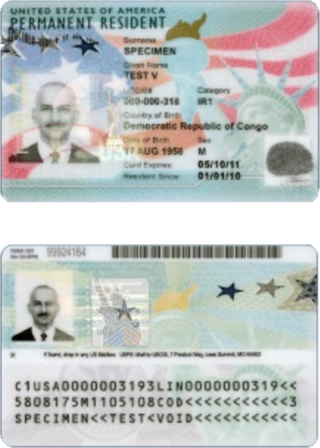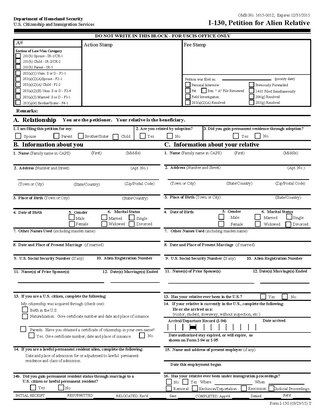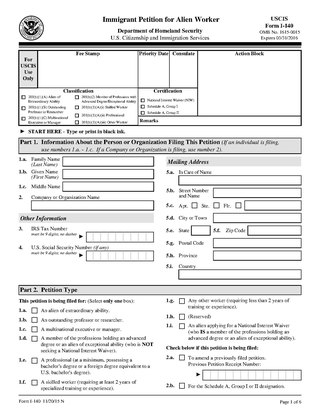Related Research Articles

A green card, known officially as a permanent resident card, is an identity document which shows that a person has permanent residency in the United States. Green card holders are formally known as lawful permanent residents (LPRs). As of 2019, there are an estimated 13.9 million green card holders, of whom 9.1 million are eligible to become United States citizens. Approximately 65,000 of them serve in the U.S. Armed Forces.
The H-1B is a visa in the United States under the Immigration and Nationality Act, section 101(a)(15)(H) that allows U.S. employers to employ foreign workers in specialty occupations. A specialty occupation requires the application of specialized knowledge and a bachelor's degree or the equivalent of work experience. The duration of stay is three years, extendable to six years, after which the visa holder may need to reapply. Laws limit the number of H-1B visas that are issued each year: 206,002 new and initial H-1B visas were issued in 2022. Employers must generally withhold Social Security and Medicare taxes from the wages paid to employees in H-1B status.
An L-1 visa is a visa document used to enter the United States for the purpose of work in L-1 status. It is a non-immigrant visa, and is valid for a relatively short amount of time, from three months to five years, based on a reciprocity schedule. With extensions, the maximum stay is seven years.
A K-1 visa is a visa issued to the fiancé or fiancée of a United States citizen to enter the United States. A K-1 visa requires a foreigner to marry his or her U.S. citizen petitioner within 90 days of entry, or depart the United States. Once the couple marries, the foreign citizen can adjust status to become a lawful permanent resident of the United States. Although a K-1 visa is legally classified as a non-immigrant visa, it usually leads to important immigration benefits and is therefore often processed by the Immigrant Visa section of United States embassies and consulates worldwide.
Optional Practical Training (OPT) is a period during which undergraduate and graduate students with F-1 status who have completed or have been pursuing their degrees for one academic year are permitted by the United States Citizenship and Immigration Services (USCIS) to work for one year on a student visa towards getting practical training to complement their education. Foreign students currently enrolled at a U.S. university can receive full-time or part-time work authorization through Curricular Practical Training. In 2021, there were 115,651 new non-STEM OPT authorizations, a 105% increase from a decade ago. According to Pew Research, there were 441,400 OPT approvals from India and 313,500 from China between 2004-2016.
U.S. Citizenship and Immigration Services (USCIS) is an agency of the United States Department of Homeland Security (DHS) that administers the country's naturalization and immigration system. It is a successor to the Immigration and Naturalization Service (INS), which was dissolved by the Homeland Security Act of 2002 and replaced by three components within the DHS: USCIS, Immigration and Customs Enforcement (ICE), and Customs and Border Protection (CBP).
The V visa is a temporary visa available to spouses and minor children of U.S. lawful permanent residents. It allows permanent residents to achieve family unity with their spouses and children while the immigration process takes its course. It was created by the Legal Immigration Family Equity Act of 2000. The Act is to relieve those who applied for immigrant visas on or before December 21, 2000. Practically, the V visa is currently not available to spouses and minor children of LPRs who have applied after December 21, 2000.
An H-2A visa allows a foreign national worker into the United States for temporary agricultural work. There are several requirements of the employer in regard to this visa. The H-2A temporary agricultural program establishes a means for agricultural employers who anticipate a shortage of domestic workers to bring non-immigrant foreign workers to the U.S. to perform agricultural labor or services of a temporary or seasonal nature. In 2015 there were approximately 140,000 total temporary agricultural workers under this visa program. Terms of work can be as short as a month or two or as long as 10 months in most cases, although there are some special procedures that allow workers to stay longer than 10 months. All of these workers are covered by U.S. wage laws, workers' compensation and other standards; additionally, temporary workers and their employers are subject to the employer and/or individual mandates under the Affordable Care Act. Because of concern that guest workers might be unfairly exploited the U.S. Department of Labor Wage and Hour Division is especially vigilant in auditing and inspecting H-2A employers. H-2A employers are the only group of employers who are required to pay inbound and outbound transportation, free housing, and provide meals for their workers. H-2A agricultural employers are among the most heavily regulated and monitored employers in the United States. Unlike other guest worker programs, there is no cap on the number of H-2A visas allocated each year.
An H-4 visa is a United States visa issued to dependent family members of H-1B, H-1B1, H-2A, H-2B, and H-3 visa holders to allow them to travel to the United States to accompany or reunite with the principal visa holder. A dependent family member is a spouse or unmarried child under the age of 21. If a dependent of an H-1B, H-1B1, H-2A, H-2B, or H-3 worker is already in the United States, they can apply for H-4 immigration status by filing Form I-539 for change of status with United States Citizenship and Immigration Services (USCIS).
The EB-1 is a preference category for United States employment-based permanent residency. It is intended for "priority workers". Those are foreign nationals who either have "extraordinary abilities", or are "outstanding professors or researchers", and also includes "some executives and managers of foreign companies who are transferred to the US". It allows them to remain permanently in the US.
The American Competitiveness in the 21st Century Act (AC21) was an act passed by the government of the United States in October 2000, pertaining to immigration to the United States. It was a complement to the American Competitiveness and Workforce Improvement Act that had been passed in 1998. The focus of AC21 was to change rules related to portability and caps for the H-1B visa to increase the effective number of visas available and make it easier for workers on those visas to switch jobs. Although the language of the Act references the Immigration and Naturalization Service (INS), the INS would soon be restructured and the functions of the INS referenced in AC21 would be handled by United States Citizenship and Immigration Services.
The H-1B Visa Reform Act of 2004 was a part of Title IV of the Consolidated Appropriations Act, 2005 in the United States that focused on changes to regulations governing H-1B visas. It was a successor to previous legislative changes affecting the H-1B, namely: the Immigration Act of 1990, American Competitiveness and Workforce Improvement Act (ACWIA) of 1998, and the American Competitiveness in the 21st Century Act (AC21) of 2000. The Consolidated Appropriations Act was signed by George W. Bush, then President of the United States, in early December 2004.
Premium Processing Service refers to an optional premium service offered by the United States Citizenship and Immigration Services to employers filing Form I-129 or Form I-140. To avail of the service, the employer needs to file Form I-907 and include a fee that is $1,500 for the H-2B and R classifications and $2,500 for all others.

Form I-130, Petition for Alien Relative is a form submitted to the United States Citizenship and Immigration Services by a United States citizen or Lawful Permanent Resident petitioning for an immediate or close relative intending to immigrate to the United States. It is one of numerous USCIS immigration forms. As with all USCIS petitions, the person who submits the petition is called the petitioner and the relative on whose behalf the petition is made is called the beneficiary. The USCIS officer who evaluates the petition is called the adjudicator.
A Notice of Intent to Deny (NOID) is a notice issued by the United States Citizenship and Immigration Services to petitioners for residency, citizenship, family visas, and employment visas. Examples of petitions for which a NOID may be issued are Form I-129, Form I-140, and Form I-130.
A Notice of Intent to Revoke (NOIR) is a communication sent by the United States Citizenship and Immigration Services to a petitioner about a previously approved petition, telling him or her that the USCIS intends to revoke the petition, along with the reasons for revocation, and giving the petitioner a fixed amount of time to respond. NOIRs may be issued for immigrant visa petitions and for non-immigrant visa petitions.
The National Visa Center (NVC) is a center that is part of the U.S. Department of State that plays the role of holding United States immigrant visa petitions approved by the United States Citizenship and Immigration Services until an immigrant visa number becomes available for the petition, at which point it arranges for the visa applicant(s) to take the visa interview at a consulate abroad. It is located in Portsmouth, New Hampshire. It was established on July 26, 1994, on the site of an Air Force base that was closed down by The Pentagon.
The Legal Immigration Family Equity Act of 2000, also known as the LIFE Act and as the Legal Immigration and Family Equity Act, along with its Amendments, made some changes to laws surrounding immigration for family members of United States citizens and Lawful Permanent Residents, as well as people eligible for employment-based immigrant visas, in the direction of making it easier for family members and immigrant workers to move to and adjust status within the United States. It was passed on December 21, 2000, as title XI of Pub. L. 106–553 (text)(PDF).

Form I-140, Immigrant Petition for Alien Worker is a form submitted to the United States Citizenship and Immigration Service (USCIS) by a prospective employer to petition an alien to work in the US on a permanent basis. This is done in the case when the worker is deemed extraordinary in some sense or when qualified workers do not exist in the US. The employer who files is called the petitioner, and the alien employee is called the beneficiary; these two can coincide in the case of a self-petitioner. The form is 6 pages long with a separate 10-page instructions document as of 2016. It is one of the USCIS immigration forms.
The Administrative Appeals Office, full name USCIS Administrative Appeals Office, and also known as the AAO and USCIS AAO, is an office within United States Citizenship and Immigration Services (USCIS) that can be used by petitioners to appeal adverse USCIS decisions made on their petitions. It is located in Washington, D.C., and all its in-person functions happen only in Washington, D.C.
References
- 1 2 Thibodeau, Patrick (June 6, 2016). "Lawsuit seeks to replace H-1B lottery with a filing-date-based system. Current distribution system called unfair and illegal". Computerworld. Retrieved August 15, 2017.
- 1 2 3 4 Ramos, Cassie (August 22, 2016). "Lawsuits Question Procedure and Substance of H-1B Lottery". National Law Review . Retrieved August 15, 2017.
- 1 2 3 4 5 6 7 8 9 "H-1B Lottery Lawsuit" . Retrieved August 13, 2017.
- 1 2 3 4 5 Koski, Ceridwen (March 28, 2017). "Controversial H-1B Lottery Upheld". The National Law Review. Retrieved August 13, 2017.
- 1 2 Thibodeau, Patrick (March 23, 2017). "H-1B lottery's game of chance is legal, judge rules. The government will be able to distribute H-1B visas via lottery in April as usual". Computerworld. Retrieved April 15, 2017.
- ↑ "Consolidated Appropriations Act, 2005". United States Government Publishing Office. December 8, 2004. Retrieved March 29, 2015.
- ↑ Xie, Jeff (December 21, 2004). "H-1B Visa Reform Act of 2004 -- H.R.4818". uslawnet.com, Xie Law Offices, LLC. Retrieved March 29, 2015.
- ↑ "USCIS TO IMPLEMENT H-1B VISA REFORM ACT OF 2004" (PDF). United States Citizenship and Immigration Services. December 9, 2004. Retrieved March 29, 2015.
- ↑ "70 FR 23775 - ALLOCATION OF ADDITIONAL H-1B VISAS CREATED BY THE H-1B VISA REFORM ACT OF 2004". Federal Register. May 5, 2005. Retrieved August 13, 2017.
- ↑ "70 FR 23775 - ALLOCATION OF ADDITIONAL H-1B VISAS CREATED BY THE H-1B VISA REFORM ACT OF 2004". U.S. Government Programming Office. May 5, 2005. Retrieved August 13, 2017.
- ↑ "USCIS Reached FY 2008 H-1B Cap" (PDF). United States Citizenship and Immigration Services. April 3, 2007. Retrieved August 12, 2017.
- ↑ Thibodeau, Patrick (May 24, 2016). "Lawsuit seeks the secrets behind the H-1B lottery. USCIS is redacting details about the lottery". Computerworld. Retrieved August 15, 2017.
- ↑ Olivo, Natalie (May 23, 2016). "FOIA Suit Seeks To Peek Into 'Black Box' Of H-1B Lottery". Law360. Retrieved August 13, 2017.
- 1 2 "FOIA Lawsuit on H-1B Lottery Policies and Procedures. AILA v. USCIS, et al., No. 1:16-cv-00956 (D.D.C. filed May 20, 2016)". American Immigration Council. Retrieved August 13, 2017.
- ↑ "Lawsuit Seeks Transparency in H-1B Lottery Process". American Immigration Lawyers Association. May 23, 2016. Retrieved August 13, 2017.
- ↑ "Defendant's Answer to Plaintiff's Claim for Declaratory and Injunctive Relief" (PDF). August 1, 2016. Retrieved August 13, 2017.
- ↑ Dellon, Leslie (May 23, 2016). "Lawsuit Against DHS and USCIS Seeks Transparency in H-1B Lottery Process". Immigration Impact. Retrieved August 15, 2017.
- 1 2 Kowalski, Daniel (June 3, 2016). "H-1B Lottery Lawsuit Filed - Tenrec v. USCIS". LexisNexis. Retrieved August 13, 2017.
- 1 2 Thibodeau, Patrick (September 23, 2016). "Court ruling puts future of H-1B lottery in doubt. Effort to end H-1B lottery wins key decision in a federal court on Thursday". Computerworld. Retrieved August 13, 2017.
- 1 2 3 "Tenrec v. USCIS" (PDF). June 2, 2016. Retrieved August 14, 2017.
- ↑ "First Amended Class Allegation Complaint" (PDF). June 29, 2016. Retrieved August 15, 2017.
- ↑ "Motion for Class Certification" (PDF). July 7, 2016. Retrieved August 15, 2017.
- ↑ "Plaintiffs' Motion for Summary Judgment" (PDF). July 7, 2016. Retrieved August 15, 2017.
- ↑ "Defendant's Motion to Dismiss the complaint" (PDF). August 8, 2016. Retrieved August 15, 2017.
- ↑ "Opinion and Order" (PDF). September 22, 2016. Retrieved August 15, 2017.
- ↑ "Judge Denies Govt. Motion to Dismiss H-1B Lottery Lawsuit - Tenrec, Inc., v. USCIS". LexisNexis. September 22, 2016. Retrieved August 15, 2017.
- ↑ "Opinion and Order" (PDF). March 17, 2017. Retrieved August 15, 2017.